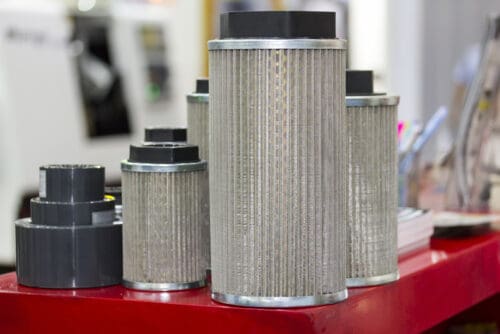
Staying up-to-date with proper filter changes can save big headaches in the long run by preventing equipment downtime, decreased performance, and lost revenue. We’ll walk you through how to know when it’s time for a new hydraulic filter so you can ensure reliability and efficiency across your operations.
What Happens During Contamination in Hydraulic Filters
Particle contamination is one common concern in a hydraulic oil filter. These can cause clogs, leading to pressure drop across the system since fluids can’t pass freely. In these cases, the results may be devastating. If the system has a bypass valve, the fluid will pass through once the pressure reaches critical levels, and unfiltered fluid will pass unhindered.
Alternatively, the contaminants will continue to pass because the clogged filter causes the pressure drop to increase until it collapses. Now, the contaminants have infiltrated both the system and the filter itself. If the filter doesn’t collapse and the pressure levels rise too high, it can still cause damage to the system’s internal parts and components.
Importance of the Right Filter Size
Choosing the right hydraulic oil filter size matters to get the most out of your hydraulic system. The filter must be appropriately sized to keep the pressure drop compatible with the contaminated fluid passing through. The right size also helps you determine the dirt-holding capacity of the system to avoid changing the filters too early or too late.
Here are some considerations:
- Pump’s flow rate
- Pipe size
- Working system pressure
- Type of hydraulic fluid
- Fluid’s viscosity
- Type of pump being used
- Filtration level
- Type of filter required
- System’s operation
- System’s operating temperature
With these considerations, you can choose a suitable filter size that can withstand contaminants while keeping you on track as you follow your maintenance schedule. It ensures your entire subsystem is protected while it operates seamlessly.
Establish a Routine Maintenance
It’s economical to have routine maintenance when it comes to changing the filter of your hydraulic system. A schedule will prevent unexpected failures leading to downtimes and costly replacements or repairs. Filters should be changed when the capacity is at 80% before it reaches its bypass stage.
With that said, there are three filter locations to remember for optimal performance:
- Off-line filtration: Offer flexibility in placement and provide continuous filtration.
- Return filtration: Protects against contaminants when the fluid returns to the tank. It’s an economical way of maintaining cleanliness.
- Pressure filtration: Safeguards components downstream when filtering particles from a high-pressure hydraulic filter.
Your system’s hydraulic filters require preventative maintenance as it will ensure that it runs with better efficiency at all times. It will solve any clogged filter problems before it begins, maintaining cleanliness and preventing significant damage. Ultimately, it can help you save money and time in the long run.
Prevent Contaminants with the Right Filter & Following Your Scheduled Maintenance
Implementing a maintenance schedule will make it easier for you to maintain the upkeep of your system while avoiding unnecessary costs due to unexpected damage. Remember always to use the correct type of filter for your system and make sure it’s appropriately sized.
If you’re looking for hydraulic filters and cylinders, don’t hesitate to contact us today. Request a quote, and our team at DOMS Incorporated will help you find the best product for your hydraulic system.



